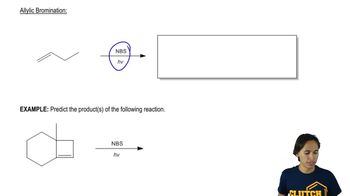Here are the essential concepts you must grasp in order to answer the question correctly.
Hydrogenation
Hydrogenation is a chemical reaction that involves the addition of hydrogen (H2) to an unsaturated compound, such as an alkyne or alkene, in the presence of a catalyst. In this case, using H2 with Pd/BaSO4 and quinoline selectively reduces pent-1-yne to a cis-alkene, due to the catalyst's ability to facilitate the addition of hydrogen across the triple bond without fully saturating it.
Recommended video:
The definition of hydrogenation.
Electrophilic Addition of Bromine
The electrophilic addition of bromine (Br2) to alkenes and alkynes involves the formation of a cyclic bromonium ion intermediate, which leads to the addition of bromine across the double or triple bond. When one equivalent of Br2 reacts with pent-1-yne, it results in the formation of a dibrominated alkene, while two equivalents of Br2 will fully saturate the triple bond, yielding a vicinal dibromide.
Recommended video:
Mechanism of Allylic Bromination.
Regioselectivity and Stereochemistry
Regioselectivity refers to the preference of a chemical reaction to yield one structural isomer over others, while stereochemistry deals with the spatial arrangement of atoms in molecules. In the case of bromination, the regioselectivity will determine which carbon atoms of pent-1-yne are brominated, and the stereochemistry will influence whether the resulting dibromide is formed as a cis or trans isomer, depending on the reaction conditions.
Recommended video:
Polymer Stereochemistry Concept 1
 Verified step by step guidance
Verified step by step guidance Verified video answer for a similar problem:
Verified video answer for a similar problem:



 2:15m
2:15m